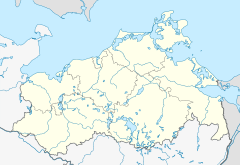
Mecklenburg is a historical region in northern Germany comprising the western and larger part of the federal-state Mecklenburg-Western Pomerania. The largest cities of the region are Rostock, Schwerin, Neubrandenburg, Wismar and Güstrow.

Mecklenburg-Vorpommern, also known by its anglicized name Mecklenburg–Western Pomerania, is a state in the north-east of Germany. Of the country's sixteen states, Mecklenburg-Vorpommern ranks 14th in population; it covers an area of 23,300 km2 (9,000 sq mi), making it the sixth largest German state in area; and it is 16th in population density. Schwerin is the state capital and Rostock is the largest city. Other major cities include Neubrandenburg, Stralsund, Greifswald, Wismar, and Güstrow. It was named after the two regions of Mecklenburg and Fore Pomerania.
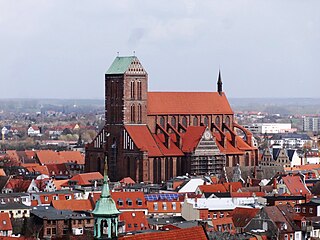
Wismar, officially the Hanseatic City of Wismar is, with around 43,000 inhabitants, the sixth-largest city of the northeastern German state of Mecklenburg-Vorpommern, and the fourth-largest city of Mecklenburg after Rostock, Schwerin and Neubrandenburg. The city was the third-largest port city in former East Germany after Rostock and Stralsund.
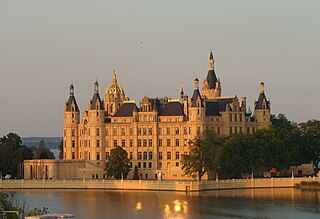
Schwerin is the capital and second-largest city of the northeastern German state of Mecklenburg-Vorpommern as well as of the region of Mecklenburg, after Rostock. It has around 96,000 inhabitants, and is thus the least populous of all German state capitals.
Nordwestmecklenburg is a Kreis (district) in the north-western part of Mecklenburg-Vorpommern, Germany. It is situated on the coast of the Baltic Sea and borders on Schleswig-Holstein to the west. Neighboring districts are Rostock, Ludwigslust-Parchim and the district-free city Schwerin, and the district Lauenburg and the district-free city Lübeck in Schleswig-Holstein. The district seat is the town Wismar.

Schwerin Castle is a 19th-century Schloss built in the historicist style located in the city of Schwerin, the capital of Mecklenburg-Vorpommern state, Germany. It is situated on an island in the city's main lake, Lake Schwerin.

Theodor Martens was a 19th-century German artist.

Walfisch is an uninhabited German island, in the Bay of Mecklenburg in the Baltic Sea. It lies approximately 4.5 kilometres (2.8 mi) north of the city of Wismar, south of the island of Poel. The island is very flat and has a maximum circumference of about 500 by 300 metres, a surface area of 20 hectares and is a nature reserve.

Klütz is a town in the Nordwestmecklenburg district, in Mecklenburg-Western Pomerania, Germany. It is situated near the Baltic Sea coast, 22 km northwest of Wismar, and 33 km northeast of Lübeck. It is famous for the manor house Bothmer Castle, located just outside the village. In the centre of the village lies the medieval Brick Gothic village church, dedicated to Our Lady. There is also a centre of literature named after writer Uwe Johnson in the town.
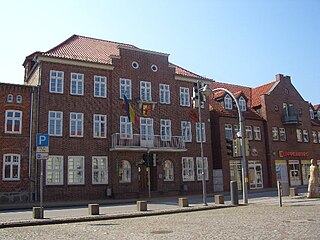
Neukloster is a town in the east of the district of Nordwestmecklenburg, Mecklenburg-Western Pomerania, Germany. This town is the administrative center of the bureau Neukloster-Warin, which includes eight more communes.

Bad Kleinen is a municipality in the Nordwestmecklenburg district, in Mecklenburg-Vorpommern, Germany. It is located on the north bank of the Schweriner See. Bad Kleinen is part of the Hamburg Metropolitan Region.

Dorf Mecklenburg is a municipality in the Nordwestmecklenburg district, in Mecklenburg-Vorpommern, Germany. It is located 6 km south of Wismar. It is home to the castle "Mikilenburg", that gave its name to the whole region known as Mecklenburg.

Lübstorf is a municipality in the Nordwestmecklenburg district, in Mecklenburg-Vorpommern, Germany.
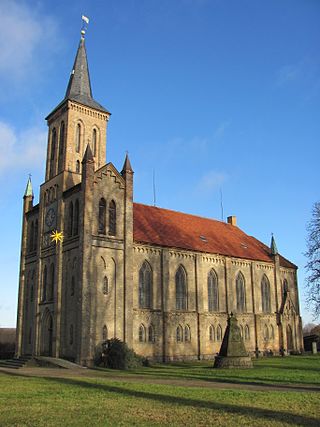
Selmsdorf is a municipality in the Nordwestmecklenburg district, in Mecklenburg-Vorpommern, Germany located east of Lübeck.

Ventschow is a municipality in the Nordwestmecklenburg district, in Mecklenburg-Vorpommern, Germany.

Mecklenburg Castle was a medieval castle and a residential capital of the Nakonid and Nikloting dynasties of the Obotrites. It was located just south of the modern village Dorf Mecklenburg, seven kilometres south of the Bay of Wismar in Mecklenburg-Vorpommern, Germany. The only remnants of the ruined castle are parts of an earthen wall. Some scholars have associated Mecklenburg with the medieval trading emporium Reric.
Schönberger Land is an Amt in the district of Nordwestmecklenburg, in Mecklenburg-Vorpommern, Germany. The seat of the Amt is in Schönberg.

The Verbandsliga Mecklenburg-Vorpommern is the sixth tier of the German football league system and the highest league in the German state of Mecklenburg-Western Pomerania. Until the introduction of the 3. Liga in 2008 it was the fifth tier of the league system, until the introduction of the Regionalligas in 1994 the fourth tier.
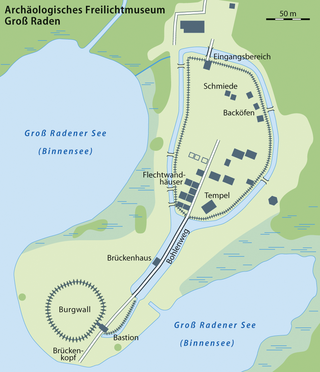
The Groß Raden Archaeological Open Air Museum lies a few kilometres north of the small town of Sternberg and about a kilometre northeast of the village of Groß Raden in the German state of Mecklenburg-Vorpommern. The site is in a depression that borders directly onto the lake of Radener See. On a peninsula in front of that lies its circular castle rampart, visible from afar, which has a diameter of 50 metres. From 1973 to 1980 extensive excavations were carried out here, led by Ewald Schuldt, during the course of which the remnants of a Slavic settlement dating to the 9th and 10th centuries was unearthed. The fort has been reconstructed based on the excavations and established as an archaeological open-air museum. It has been enhanced by finds from the Slavic castle of Behren-Lübchin.

Ludwigslust-Parchim II – Nordwestmecklenburg II – Landkreis Rostock I is an electoral constituency represented in the Bundestag. It elects one member via first-past-the-post voting. Under the current constituency numbering system, it is designated as constituency 13. It is located in western Mecklenburg-Vorpommern, comprising the eastern parts of the districts of Ludwigslust-Parchim and Nordwestmecklenburg, and the northwestern part of Landkreis Rostock.

